
Our Training tips have been assembled to incorporate advice and guidance from a variety of dog experts, trainers’, behaviourists’ veterinary professionals and several anonymous personnel involved with animal welfare organisations. The content has also been influenced by contributions from our very large client base.
Thousands of dogs’ lives have been saved In a recent survey of PACDOG clients, over 50% owned dogs that originally suffered from ‘selective hearing’. Again, 50% had had ‘chasers’, of whom 70% worried sheep. Over 90% of all clients claimed that their PACDOG training had been successful. An out of control dog is a danger to itself, a menace to others and a huge liability to its owner. Not only is the dog at risk of getting shot or run over, but it could also cause accidents that at worst can be fatal. A dog that just cannot be trusted, or that is persistently disobedient, unruly, or plain anti-social, despite hours, days, weeks or months of attempted conventional training, is a threat to its own longevity. Thus the dog becomes a prisoner to the house or yard; and, if they are lucky enough to get ‘exercised’, they will also be a lifelong prisoner to the lead, which is no life for your dog – nor satisfaction for you, since one of the main pleasures of owning a dog is to see it enjoying itself. If your dog is driving you to distraction… and driving itself to an early demise through sheep chasing, deer hunting or harassing any other animal several fields or gardens away – or simply being a nuisance to others in the park, then the powerful arm of a PACDOG Remote Trainer should enable you to discourage your dog, quickly and for all time. If you can still see your dog half a mile (800 metres) or more away, or if it can still hear your voice- or whistle-commands, then the Remote Trainer can extend your sphere of influence and control with confidence. Indeed, the level of correction, whether it need be a mild ‘pins and needles’ sensation (or strong vibration correction with the PAC Buzz collar) for minor disobedience problems – or a more appropriately powerful deterrent against life threatening Or anti-social behaviour will always be faithfully reproduced. The distance between the trainer and the dog will not affect the required correction strength. A PACDOG Remote Trainer is a wonderful aid to training where conventional methods have failed, but it is not intended either as a short cut to conventional training or an excuse for poor or shoddy training. It must also be stressed that it is a training aid – not a punishment tool. Furthermore, the unit is not itself a trainer. That responsibility lies in your hands. If you are of the school that believes that more gets rapid results, or you are of an impetuous disposition, then It Is very unlikely that this tool is for you. For the sake of your dog’s welfare, never allow access to this equipment, either to children – or anyone else who is unaware of the collar’s function and its recommended usage. 
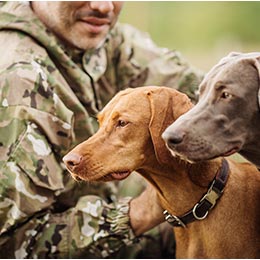

Why Use a PACDOG Remote Training CollarIt is utterly pointless attempting to correct a dog some minutes, or even seconds after it has ‘committed an offence’, since it will hardly be able to associate the punishment with the crime. Any late reprimand will not be understood, making the dog believe that the trainer is cruelly dominant, and cause them to be reluctant in future to come back… just to be ‘punished’. Training then takes a giant leap – backwards! Furthermore, corporal punishment can easily result in damage to the dog, both psychologically and physically. Not all dogs respond to standard “compulsive” or -reward” training methods, and until you encounter a difficult dog, it is hard to imagine the need for a PACDOG Remote Trainer. The use of such a tool as a last resort can be extremely effective in curing a comprehensive range of problems – quickly and usually pain-free. Correct use of the device will inevitably elevate the trainer to surrogate ‘pack-leader’ or ‘top dog’ … Indeed, once the trainer has established their dominant position, there should be no need for them to be the least bit physical with the dog; and, before long, a calm but firm word (or whistle) command should suffice. Indeed, constantly ‘nagging’ a headstrong dog will be a thing of the past. Making walks or training sessions much more pleasurable for both the dog and trainer. The enormous power of the PACDOG system, as a training instrument, lies not so much with the strength of correction available, which can be awesome, but more with the timing of the correction, either during or immediately following the deed. It is believed that a dog’s limited ability for logical reasoning will cause them quickly to associate disobedience or undesirable act, with the correction. The message gets home very quickly and because the timing is so immediate, the level of correction needs most often to be no more than a slight tickling discomfort or a very strong vibration with the PAC Buzz collar. Since it is possible to use such low levels of correction, it will not inhibit the dog’s spirit. Indeed, the correction should be rather like a very long, invisible check-cord that tingles, but does not tangle. Many users have found that their dogs tend to bond more closely when they have been trained with the PACDOG Remote Trainer. This most likely happens because, after a correction, the dog comes back with the view that “There’s something quite scary out there – but at least you’re a friendly face- and you can praise them for being so good! The use of the tone or Vibration facility in conjunction with, or in place of, electrical stimulation (or Strong Vibration correction on PAC BUZZ Collar), enhances even further the PACDOG Series as the quickest, most effective and most humane training tool available (see Tone or Vibration Function). 
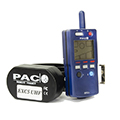

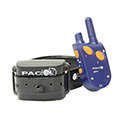
The Dummy Familiarisation PeriodIt is very important that your dog does not associate the correction with the PACDOG collar. Otherwise you will have lost some of your advantage, since it will soon realise that when it is wearing the collar they will have to behave itself. And when it is not … it can do just what it jolly well pleases! As a result they will very likely have to wear the collar most of the time when out; and the system starts to be used as a deterrent, rather than a training tool. To avoid this realisation, you will need to familiarise your dog with the collar by fitting the PACDOG Collar on the dog, turned off, for at least 10 – 14 days, before you enter the active training phase The main aim of the “dummy phase” Is to condition your dog to the shape, weight and feel of this strange, new PACDOG collar. To ensure a good result, the dog should be made to wear it more or less continuously (but no more than 12 hours a day) for the first two or three days … and certainly always when taken out for exercise. Indeed, to make sure that the dog treats the new PACDOG collar with complete indifference, take the PACDOG collar off, at home and during walks, count till, 10, and then put the PACDOG collar back on. Do this several times, every day, almost ad nauseam. But during the first week, fit the PACDOG collar loosely (make sure collar is still turned off at this stage) so that it flops around and make its presence felt, deliberately making the dog aware that it is there. They then get used to it; soon ignores it and forgets about it. Thereafter, for the next few days, whenever you take them out, fit the PACDOG collar just a little bit tighter each time. Positioned centrally on the front of the neck, you can just get each of two fingers under the two probes*. If the dog’s neck tapers, position the PACDOG collar at the narrowest section (nearest the head). Most dogs will eventually associate the fitting of the PACDOG collar with good fun and after several days you should have achieved this objective. The ideal position of the contact probes is at the front centre point of the neck. Progression to Live TrainingIf your dog needs to be taken out on a lead, or to be attached to a line, they should also wear a normal collar at the same time. Never attach a line to the PACDOG collar, as this might damage it. If you feel you might need to use a line during training with the PACDOG collar, give them complete freedom of the line. Do not be in too much of a hurry to introduce your dog to a live situation. Ideally you should only do this after you have firmly established an appropriate intensity setting – for your dog – and that you are getting a positive response. Despite all the subterfuge with the “dummy” process, there have been instances where some dogs also get to associate the correction with the presence of the PACDOG handset. It is our strong recommendation, therefore, that you are very discreet when handling it (the handset}. Ideally it should be kept out of sight – under your jacket – or perhaps in a top jacket-pocket. If your dog were to suspect the PACDOG handset had something to do with the corrections, they would start to regard it as the ‘thing’ rather than ‘you as top dog’ with miraculous power; possibly diminishing some of your advantage. BUT, just In case you are unable to hide it, carry the PACDOG handset with you (using the lanyard around your neck) during the “dummy” training period to disguise and enhance the effect. Important: Be careful not to over tighten the PACDOG collar: and remember always (at least daily) to check for soreness before fitting the PACDOG collar. Avoid leaving the PACDOG collar on for over 12 hours per day and wash the dog’s neck area weekly. In the event of any sign of irritation, leave the PACDOG collar off for a day or two, before progressing with your training programme. If longer sessions are necessary (e.g. on a long walk), make more frequent checks for soreness or irritation – especially if you are using the smaller radius probes (for thicker coated breeds). Just as it is unwise to leave a car unattended with its engine running, it is safer, and therefore preferable, not to leave an active PACDOG collar on an unattended dog for long periods of time, particularly since the prolonged wearing of a ‘snug-fitting’ collar is likely to become uncomfortable. Also, by the same token, although faults on active PACDOG collars are extremely rare, this precautionary measure will avoid any chance of inadvertent accidental or even malicious actuation. 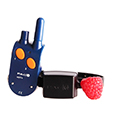

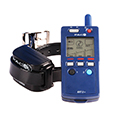

Setting the Right Level of CorrectionThe stimulation correction level (intensity) or strong vibration correction level on PAC Buzz collar is controlled solely from the handset. Depending on the PACDOG handset model this intensity is controlled from a dial on the handset whereas on others, it is controlled by pressing the appropriate, pre-set-level trigger. See the PACDOG Instructions for use for your particular PACDOG Remote Trainer model. Irrespective of size, breed and type of problem, each dog is an individual. It is important, therefore, before starting your first active training session, that you establish the most appropriate correction level for your dog. While it may seem logical to assume that a small dog will need less corrective stimulation (or strong vibration correction level on PAC Buzz collar) than the bigger dog, this is not always the case. There are many examples of large dogs, such as Great Danes, that are highly sensitive and of some smaller dogs, such as Beagles that require a much higher level of correction. Furthermore, among dogs of the same breed, and even among dogs from the same litter, there can be wide variation of reaction to a particular correction level. In addition, the Insulating effect of the fur on longhaired breeds will often require a higher setting … or the use of different probes (see the PACDOG instructions for use). Certainly, since a dog’s ears are often blocked by adrenaline whilst chasing a quarry, it may well be necessary temporarily to increase the stimulation level, or strong vibration correction level on PAC Buzz collar. It is also worth bearing in mind that a dogs pain threshold is mostly, significantly higher than that of a human. Testing the correction level on yourself (e.g. on your arm) is not likely to be very meaningful, but it is as well that you should be aware of the sort of correction that you are administering. To find the appropriate correction level for obedience training for your particular dog, select initially the minimum level of electrical stimulus or strong vibration correction on the PAC Buzz collar, on your PACDOG handset. When you press the trigger you should see a mild but positive reaction. If this is not the case, gradually Increase the Intensity, a small step at a time, until you notice a slight movement of the head. This might cause them to be startled, but should not produce a greater reaction than this. Such a mild reaction should be sufficient in most cases to correct your dog’s disobedience. Beware; however, when you press the button for the first time or two, the dog might well overreact not necessarily to the strength of the correction – but to the surprise of it. Thereafter, they should no longer be so astonished at the correction. Most dogs should change a persistently disobedient behaviour within a couple of training sessions – at a level hardly more uncomfortable for them than a pins and needles sensation or a strong vibration with the PAC Buzz collar. For some of the more determined, headstrong dogs, however, the setting might have to be increased after a period of training as they become more tolerant to the correction and begin to ignore the low-Levels. On the other hand, however, if you notice that the dog is overreacting, you have clearly increased correction to a level that is too high. This must be reduced progressively, till it is just enough to get their obedient attention. If your dog enjoys plunging into water, this will increase its sensitivity. Although you can compensate for this by reducing the correction output, we would recommend that in the early stages most of your Initial training be affected away from water. But in any case, the PACDOG collars are waterproof to several metres, and should not be affected. But If the collar, and dog, have been wetted with salt water, avoid re-using till after a thorough brushing off (both collar and dog) to remove the salt water. For correction of serious anti-social habits, such as sheep chasing, the intensity level should be chosen initially to be at least half strength – and if necessary, be prepared to select the maximum level. A short correction at such high levels often only need be one-off. You are now ready for your first training session! 
|
 Go to EU Site
Go to EU Site